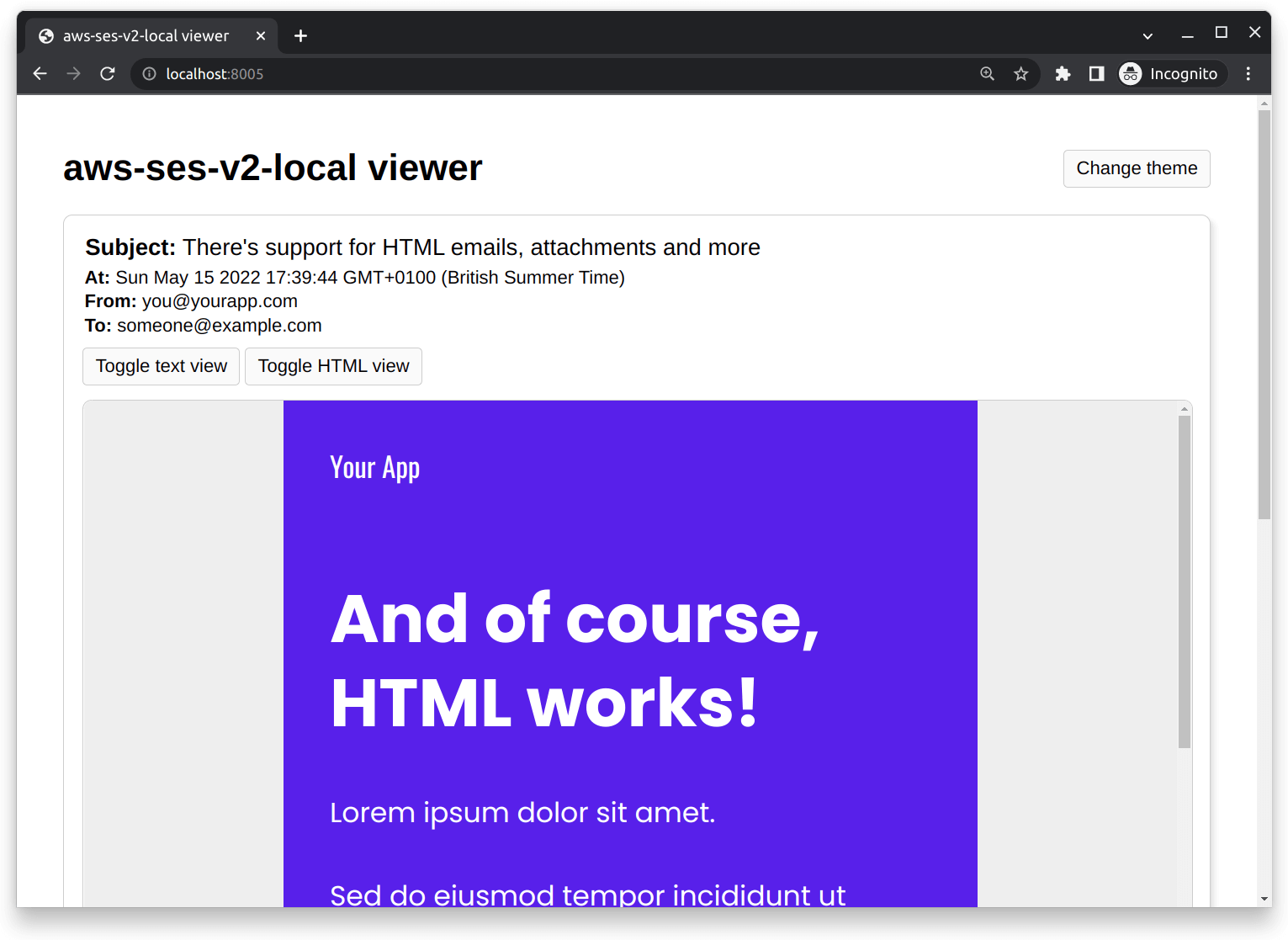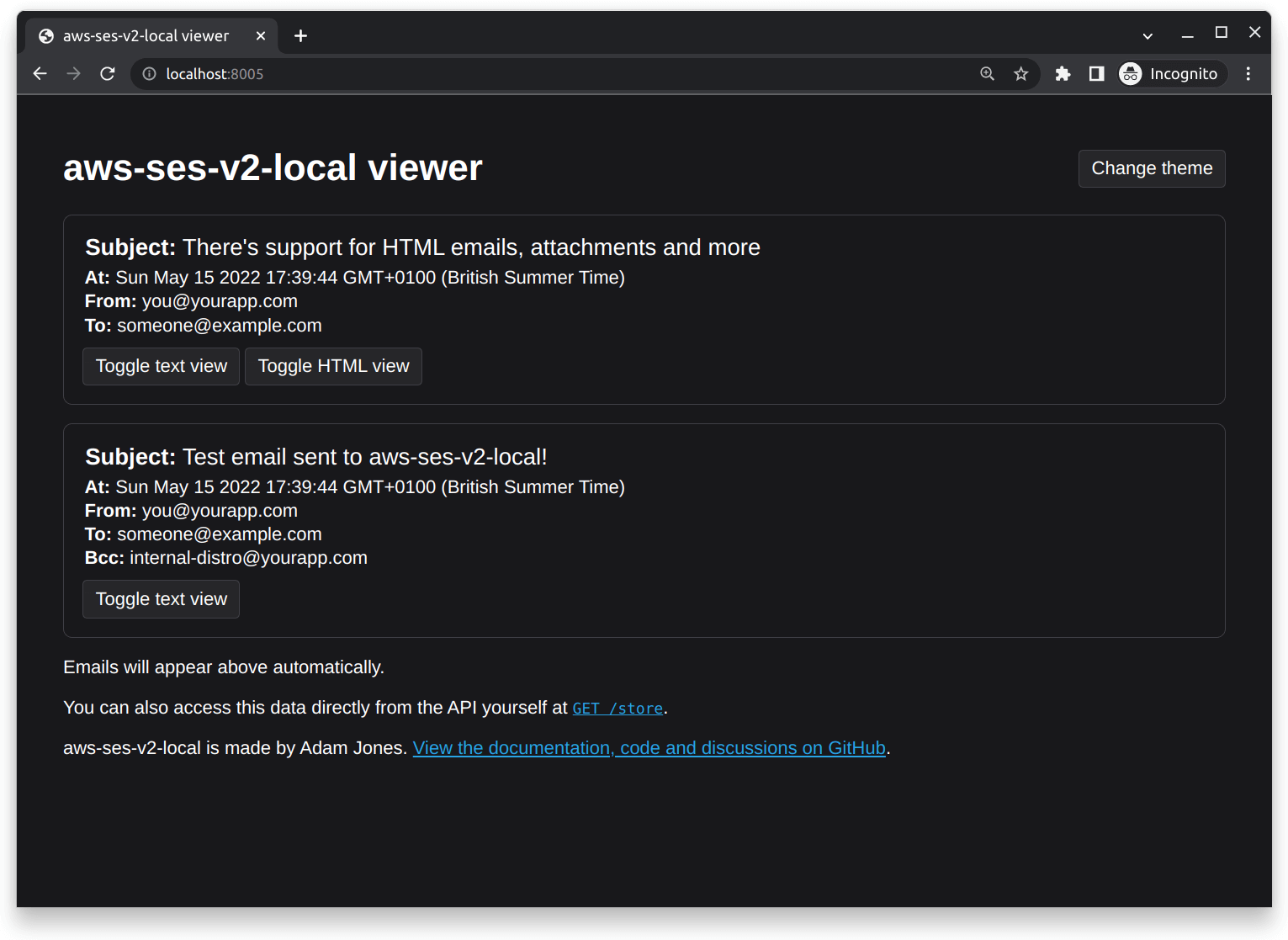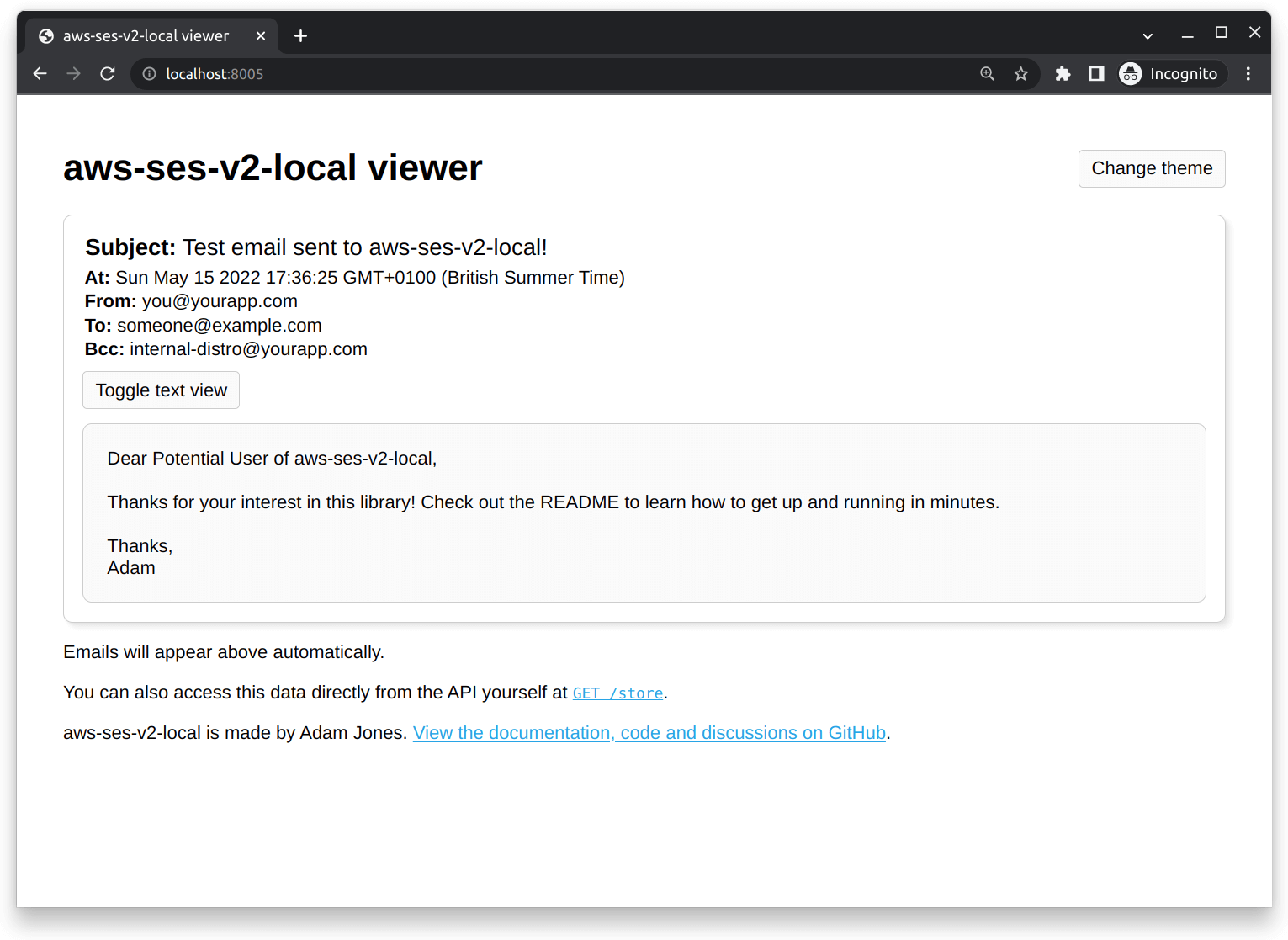A local version of Amazon Simple Email Service (AWS SES) supporting both the V1 API and the V2 API. Currently focuses on the SendEmail and SendRawEmail endpoints.
Are you using serverless-offline? You might be interested in serverless-offline-ses-v2.
| HTML emails | Dark theme |
|---|---|
 |
 |
- SES V1 SendEmail endpoint
- SES V1 SendRawEmail endpoint
- SES V2 SendEmail endpoint (both Simple and Raw)
- SES V2 createEmailTemplate endpoint
- SES V2 deleteEmailTemplate endpoint
- SES V2 getAccount endpoint (returns the content of the AWS_SES_ACCOUNT env variable)
- SES V2 sendBulkEmail endpoint (only supports simple placeholder replacement)
- Realistic API responses, compatible with the AWS SDK (in JavaScript/TypeScript/Node.js, Java, Python, Go, C++, .NET, PHP, Ruby) and the AWS CLI
- To, Cc, Bcc, ReplyTo and From addresses
- Plain text and HTML emails
- Accept and view attachments
- Built in web viewer, with live inbox, optional dark theme, and compatibility with all emails
- API access to emails at
GET /store - Health check endpoint at
GET /health-check - Control it from the CLI, or import it as a library
- TypeScript definitions
- Emails can be forwarded to a SMTP server via the SMTP_TRANSPORT env variable
npm install aws-ses-v2-local
Run it as a command line tool (in your package.json scripts, or install it globally with npm install -g aws-ses-v2-local)
aws-ses-v2-local
Alternatively, you can import it and run it yourself (along with optional config for the port):
import server from 'aws-ses-v2-local'
server({ port: 8005 })
console.log('aws-ses-v2-local: server up and running')You can treat the server as an AWS SES endpoint. See the starter for your language:
JavaScript/TypeScript for the V2 API with the V3 SDK (recommended)
import { SESv2Client, SendEmailCommand } from "@aws-sdk/client-sesv2"
const ses = new SESv2Client({
endpoint: 'http://localhost:8005',
region: 'aws-ses-v2-local',
credentials: { accessKeyId: 'ANY_STRING', secretAccessKey: 'ANY_STRING' },
});
await ses.send(new SendEmailCommand({
FromEmailAddress: 'sender@example.com',
Destination: { ToAddresses: ['receiver@example.com'] },
Content: {
Simple: {
Subject: { Data: 'This is the subject' },
Body: { Text: { Data: 'This is the email contents' } },
}
},
}))JavaScript/TypeScript for the V1 API with the V3 SDK
import { SES, SendEmailCommand } from '@aws-sdk/client-ses'
const ses = new SES({
endpoint: 'http://localhost:8005',
region: 'aws-ses-v2-local',
credentials: { accessKeyId: 'ANY_STRING', secretAccessKey: 'ANY_STRING' },
})
await ses.send(new SendEmailCommand({
Source: 'sender@example.com',
Destination: { ToAddresses: ['receiver@example.com'] },
Message: {
Subject: { Data: 'This is the subject' },
Body: { Text: { Data: 'This is the email contents' } },
},
}))JavaScript/TypeScript for the V2 API with the V2 SDK
import AWS from 'aws-sdk'
const ses = new AWS.SESV2({
endpoint: 'http://localhost:8005',
region: 'aws-ses-v2-local',
credentials: { accessKeyId: 'ANY_STRING', secretAccessKey: 'ANY_STRING' },
})
ses.sendEmail({
FromEmailAddress: 'sender@example.com',
Destination: { ToAddresses: ['receiver@example.com'] },
Content: {
Simple: {
Subject: { Data: 'This is the subject' },
Body: { Text: { Data: 'This is the email contents' } },
}
},
})JavaScript/TypeScript with nodemailer for the V1 raw API with the V3 SDK
import * as aws from '@aws-sdk/client-ses'
const ses = new aws.SES({
endpoint: 'http://localhost:8005',
region: 'aws-ses-v2-local',
credentials: { accessKeyId: 'ANY_STRING', secretAccessKey: 'ANY_STRING' },
})
const transporter = nodemailer.createTransport({ SES: { ses, aws } })
await transporter.sendMail({
from: 'sender@example.com',
to: ['receiver@example.com'],
subject: 'This is the subject',
text: 'This is the email contents',
attachments: [{
filename: `some-file.pdf`,
contentType: 'application/pdf',
content: Buffer.from(pdfBytes),
}],
})Using another language or version? Submit a PR to update this list :)
Navigate to the address and port where the server is running in your browser (e.g. localhost:8005).
A Dockerfile that bakes the /dist/cli.js is provided. There is also a docker-compose.example.yml template to create a container running the aws-ses-v2-local mock server.

